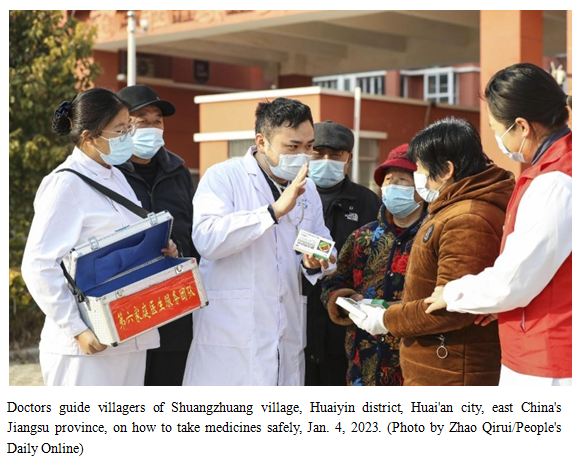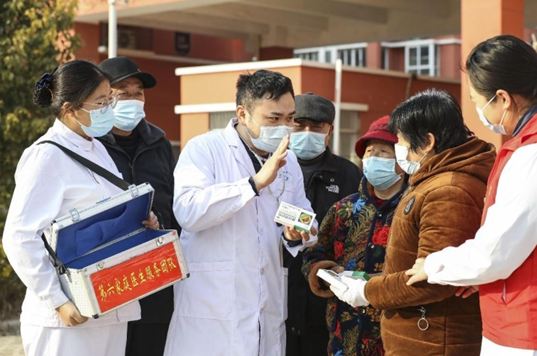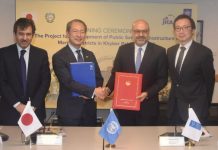By Bai Jianfeng, Liu Zhiqiang, People’s Daily
China released the 10th COVID-19 prevention and control protocol Jan. 7, outlining regular disease surveillance requirements and ramped-up measures to counter an emergency. It has also downgraded its management of COVID-19 from Class A to Class B since Jan. 8, 2023, entering a new stage of COVID-19 response.
Over the past three years, China has always maintained its strategic initiative in its fight against COVID-19. It has withstood the impact of five rounds of global COVID-19 outbreaks and effectively handled more than 100 cluster outbreaks, buying precious time for the research, development and application of vaccines and medicines, and the preparation of medical resources.
China has been optimizing and adjusting its COVID prevention and control measures in light of the evolving situation. It has effectively avoided widespread infections with the original strain and the Delta variant, which are relatively more pathogenic than the other variants.
The country also kept its rates of infection and mortality at the world’s lowest level. Despite the pandemic, the average life expectancy of the Chinese population rose from 77.3 years in 2019 to 78.2 years in 2021.
After China downgraded its management of COVID-19 from Class A to Class B, the country has shifted its focus from infection prevention to medical treatment and prevention of severe cases. It has taken relevant measures to safeguard people’s life and health to the greatest extent possible and minimize the impact of COVID-19 on economic and social development.
As the COVID-19 pandemic has raged across the globe, almost all countries have been affected to some extent.
In China, putting people’s lives and health first has been the primary consideration in formulating policies for the prevention and control of the pandemic. China has paid the treatment cost for COVID-19 patients in designated hospitals, provided free COVID-19 vaccination for all its citizens, and included anti-COVID-19 drugs in the national medical insurance system.
Articles published in the world-leading medical journal The Lancet pointed out that the Chinese government has saved thousands of lives through its huge investment in public health, and the country’s experience in fighting the COVID-19 pandemic is worth learning by other countries.
At the beginning of the new year, 31 teams made up of doctors of local public health centers, visited elderly residents of Wangtan township, Keqiao district, Shaoxing city, east China’s Zhejiang province, to give supply kits for COVID-19 to them.
“Uncle Zhang, these are the anti-epidemic kits provided by the government for senior citizens. There are medicines, face masks and disinfecting wipes in them. Please take it,” an official handed a package to an elderly resident and said.
At the end of 2022, China saw a dramatic surge in the market demand for N95 face masks. In an effort to meet the demand, companies have worked overtime to improve production capacity.
Within a month, the number of companies covered by the production scheduling mechanism established by the country’s Ministry of Industry and Information Technology (MIIT) for ensuring the supply of medical supplies increased from 50 to more than 500. The daily output of N95 masks in the country exceeded 190 million pieces, effectively guaranteeing adequate supply.
Similarly, as the country faced a tight supply of face masks in early 2020, enterprises in other industries made rapid adjustments to producing masks and other products for the fight against the pandemic. As a result, the country’s daily output of face masks grew about 13.5 times in merely 35 days.
Over the past three years, China has shown extraordinary capabilities of organization, coordination and implementation, providing a fundamental guarantee for the country to ward off risks and challenges and pool strength to overcome difficulties.
On Jan. 1, 2023, Shanghai Port in east China’s Shanghai municipality announced that its container throughput exceeded 47.3 million 20-foot equivalent units (TEUs) in 2022, ranking first in the world for 13 consecutive years.
On Dec. 28, 2022, the 2022 Global Digital Trade Conference and Wuhan (Hankoubei) Commodities Fair kicked off in Wuhan, capital city of central China’s Hubei province. The event attracted diplomatic envoys, heads of business associations, and hundreds of well-known entrepreneurs from more than 30 countries, creating a lively scene in marked contrast to the empty streets of the city three years ago when it was struck by the COVID-19 outbreak.
Shanghai and Wuhan, two cities that have gone through a tough test by the pandemic, are beaming with vitality and prosperity. It is a vivid reflection of how China has efficiently coordinated the COVID-19 response with social and economic development during the past three years.
In 2020, China was among the first countries in the world to bring the pandemic largely under control and resume production and work, and the only major economy to achieve positive growth in the pandemic-ravaged year.
In 2021, China’s gross domestic product (GDP) grew by 8.1 percent year on year, ranking it among the fastest in major economies in the world.
In the first 11 months of 2022, the total added value of industrial enterprises above the designated size in China rose by 3.8 percent year on year, and the country’s fixed-asset investment grew 5.3 percent from the same period in 2021. Its foreign trade in goods expanded 8.6 percent year on year during the period.
In 2022, despite the impacts of the COVID-19 resurgence and other unexpected factors, China’s economy registered a V-shaped recovery with an estimated annual economic output exceeding 120 trillion yuan ($17.69 trillion), once again demonstrating strong resilience.
As China’s COVID-19 response has entered a new stage, it continues to optimize its science-based COVID-19 prevention and control measures to ensure a smooth transition and maintain social stability, laying a solid foundation for steady economic recovery.
Since Jan. 8, 2023, people in China have no longer been required to take temperature checks when entering passenger terminals or taking public transport.
In addition, the country has lifted anti-COVID-19 restrictions on international passenger flights, and optimized its regulations on travel between the mainland and Hong Kong and Macao.
Various regions and authorities in the country have ramped up efforts during the transition period. At present, the country sees the accelerated resumption of work and production, gradual reopening of businesses and markets, and positive new changes in people’s work and life.
Recently, the central business districts of many cities in China have seen a resurgence, with catering and entertainment consumption rebounding quickly.
The Bund in Shanghai was crowded with people on New Year’s Eve; the SKP shopping mall in Chengdu, capital of southwest China’s Sichuan province, saw a long line on the first day of its soft opening; and the most popular shopping district in Changsha, capital of central China’s Hunan province, is jam-packed with visitors.
As the country’s COVID-19 response has been further optimized, China is unleashing its development vitality at a faster pace.
“Since the 10 new measures were rolled out to optimize COVID-19 response, the online search for air tickets surged seven times. After the COVID-19 management measures were downgraded from Class A to Class B, bookings for domestic air tickets spiked to the peak of the recent three months,” said Guo Lechun, vice-president of the big data research institute of online travel service provider Qunar.com.
Practices have proven that China enjoys the institutional advantage of its socialist market economy and the demand advantages of its super-large domestic market, the supply advantages underpinned by its complete industrial system, and sufficient human resources featuring intelligent and hardworking workers and entrepreneurs.
As long as China can truly unleash its advantages and dynamism, proceed with confidence, and pool strength, it is bound to secure a full victory in its fight against the COVID-19 pandemic.













